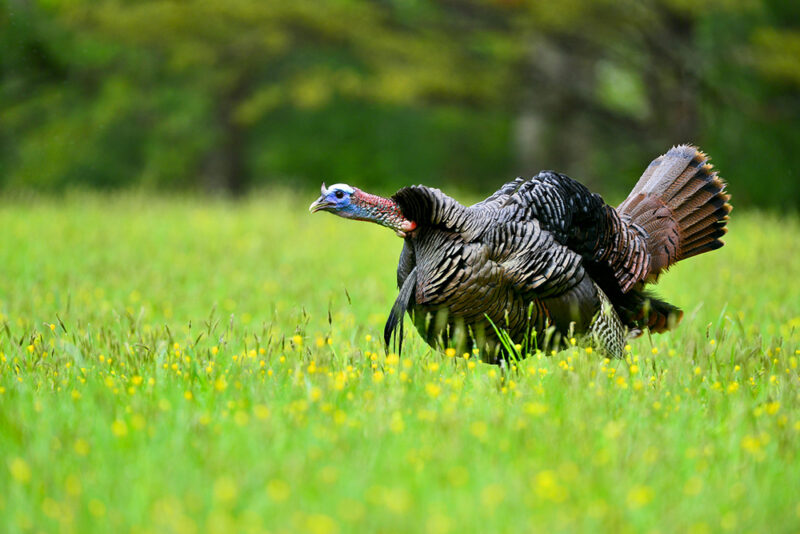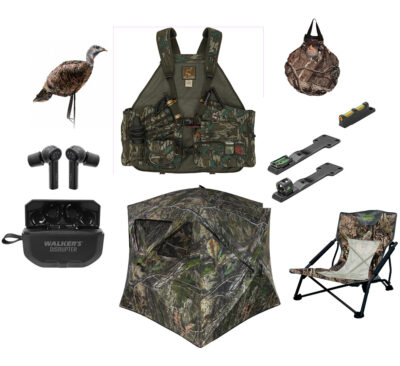By Paul Rackley, GunBroker.com Editor

Over the years, I’ve had opportunities to hunt wild turkeys in multiple states on both private and public land. Some of these hunts have been easy, with birds coming straight into the gun. Others have required long days and countless tactic changes, hoping for a single opportunity to fill a tag. The easy ones were fun, but I learned a whole lot more when pursuing tough turkeys, especially on public land.
Pressure is the biggest adversary when hunting turkeys. This is true on both public and private land. Numerous hunters trying different tactics can make turkeys closed mouth and hard to bring into range. Other factors that create tough turkeys include weather and the number of available hens. Weather can slow down or speed up breeding, and few gobblers will leave multiple mates to search for a potential hen.
Pressure, however, shuts turkeys down faster than anything else. Public land is open to everyone, so it can be crowded. This includes both other hunters and those enjoying non-hunting outdoor activities. Both groups can ruin a hunt, either by accident or on purpose; hunting etiquette is pretty hard to come by these days. Luckily, there are some ways to get around hunting pressure and be successful on tough turkeys.
Go Early
It’s been my experience that the early turkey season can bring a whole lot of hunters to the woods. This is especially true when birds are hot. As such, pressure comes quick and hard when turkeys are gobbling. Most hunters, however, don’t go that far into the woods. So, to get away from the initial crowd, I like to park early and head in well before daylight.
I have, in fact, parked up to three hours before sunrise on opening day. It was also good that I did, as about 10 minutes after I arrived, another vehicle pulled in, saw my truck and left. It didn’t really make a difference since someone came in behind me later and bumped a bird I was working. However, getting there early provided me with first access.
Go Far
One of the reasons I arrived so early at this spot was because of its size and layout. This area was big. It had about six miles between roads on the east and west sides, with a big creek on the south side and miles of trees running north. Arriving early allowed me time to trek a couple of miles in before hunting hours. This reduces contact with hunters who are less willing to get away from the road.
Now this strategy requires scouting, both via map and boot leather. Start by using maps and GPS to find a likely area, large tracts with no road access for two to five miles, are best. Then, find a hill near the middle of the area. Get in quietly a good half hour to hour before daylight. It might even be a good idea to get there earlier, if possible, to ensure being first and that everything settles back down.
Gobblers like hills for sounding off and strutting, putting you in a prime location. You are also on the inside with hunters coming in from the outside. This leads to the next tough turkey tactic.
Being down in the woods well before daylight provides an additional advantage. Some hunters only head into the woods after they hear a bird. While this strategy can work, it can also lead to bumped birds. This basically reverses the pressure. If you are down in the woods when this happens, then the birds are heading in your general direction. Success can be had with a quiet relocation and a few light calls.

Back to the Basics
There is just something about getting a bird to come in strutting, spitting and gobbling with a cadence of calls. This can, however, be counterproductive, especially on public land. One, if a gobbler is really hot, other hunters can, and will, interfere. Also, public land turkeys often get a plethora of sounds sent their way. This can make them wary or silent, and oftentimes both. Times like this is when I went back to the basics against tough turkeys.
I learned this lesson after throwing yelps, cutts and clucks at a pair of gobblers for three days. They responded to everything I threw at them, but wouldn’t come into range. I decided to follow the advice of National Wild Turkey Federation biologist Tom Hughes. When I first started turkey hunting, he told me gobblers have great hearing and topographical knowledge. They can pinpoint a location from long distances off. Because of this, hunters should “keep calling simple and be patient.” The bird just might come in later searching for that “hen.”
On the fourth morning, I took a turkey chair, got comfortable and resisted the urge to match calls with the birds. Instead, I sent out a few soft yelps early, followed by the occasional cluck and scratching. The pair came quietly into range of my 870 around 9:30. It is not always about fancy calling. Slowing down to the basics provides tough turkeys an opportunity to come in later.
Partner Up
In the turkey world, toms gobble and hens come to them. Sure, males will shorten the distance to make it easier, but hens typically close the last bit of distance. This is one of the reasons why gobblers lock up at around 70 to 80 yards.
Now I’ve used numerous tactics to get around this fact of nature. My favorite, however, is with a partner. Also known as the pivot, the idea is to call from around 30 to 40 yards behind the shooter, moving quietly, like a pivot, to keep the shooter between the caller and the gobbler. When a bird locks up it is within range of the shooter. This works particularly well with less-experienced hunters.
Walk Away
Walking away from a gobbler might seem like a sign of defeat. However, it might also be just what is needed. Interested gobblers sometimes get stubborn, refusing to come closer. These birds know that the hen is supposed to come to them. Like most males, though, gobblers have a strong sense of competition. Hunters can exploit that instinct by sounding uninterested or seeming to be heading to another gobbler.
I really like this strategy in hilly and mountainous areas, as it is easier to make calls sound like they’re further away by dropping over a hill. The idea is to walk away while calling before sneaking back to set up. That gobbler is liable to quickly try to catch up to the hen before his competition can latch hold of the girl. While this can be conducted in flatter areas, cover is required for sneaking back without being busted. I tried this in Texas to utter failure. That’s why I like hills for this. Head over the hill calling before sneaking back to the top to set up.
Go Late
One of my biggest problems with turkey hunting is getting locked onto a bird or birds and refusing to give up. A bird outsmarts me, and I take it personally. The most prominent example consists of when I spent nine mornings in a row trying to get a group of very active gobblers to come into range.
On the 10th morning I stayed in bed. I did, however, head to the woods from the office that evening. By 5:30 p.m., I was set up near where I had been working those birds. After letting things settle down, I sent out a few quiet searching yelps, with some light scratching. Within minutes three heads popped up over the hill. I was back to the truck with a bird before dark.
Lots of turkey hunters hit the woods early before heading to work. Birds get used to this, staying quiet and unresponsive until later in the day. If the birds aren’t working early, consider staying late, or simply postpone when you hit the woods to later in the day.
Spread it Out
Now some are going to think I’m a little crazy with this one, but it works. In fact, it has worked multiple times over the years, on both public and private land. The first time was on national forest land in South Carolina with a friend from the NWTF. We heard a bird as we walked in that sounded like he shock-gobbled by accident. The way he shut himself down halfway through his gobble, we realized he wasn’t going to work early.
So, we went after some other birds, leaving him for later. Around 10 a.m., we set up in a cutover with a variety of decoys, ranging from full body to silhouette hens, along with a jake and a fan. We got comfortable and settled in, calling lightly from time to time.
Shortly before noon, I roused myself up enough to kick off a few yelps from a box call. It got a response. I hit it again and the bird cut me off. Within minutes the bird was standing 45 yards away from the end of my buddy’s Mossberg 500.
Since then, I have used this spread technique on countless afternoons, especially later in the season when birds are not responding to calls. Typically, birds come in quietly. I have, in fact, fallen asleep and woke up to a gobbler standing in the middle of the decoys.
I like to set up in narrow fields and openings with as many decoys as I can carry, all hens except for a single jake that goes in the middle and maybe a fan off to the side. I spread the hens around, but keep the middle of the spread within 30 yards of my setup.
Finalizing Tough Turkeys
The concept of turkey hunting is fairly simple. Hunters make hen sounds, and gobblers walk into shotgun range. Unfortunately, turkeys don’t often seem to want to cooperate. Because of that, hunters need to learn how to swap up tactics when turkeys get tough.
These are just a few of the tactics I’ve used over the years. Some of them I learned via experience in the woods. Others came from discussions with other turkey hunters. These tactics don’t work every time. But if a turkey has gotten tough, you’ve got change it up to be successful.
Related Article: Shotguns of 2024; What to Consider






